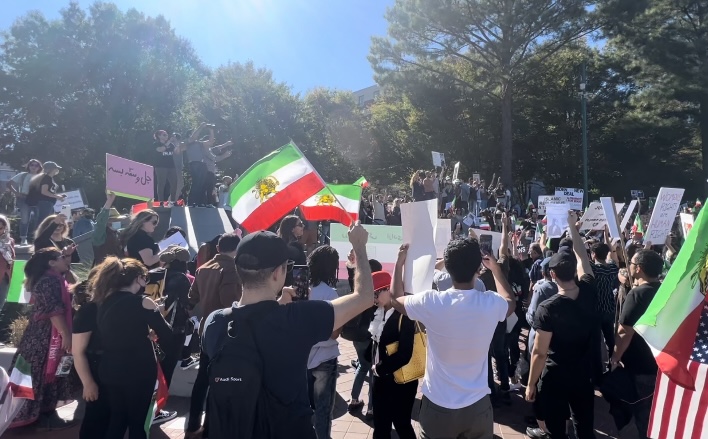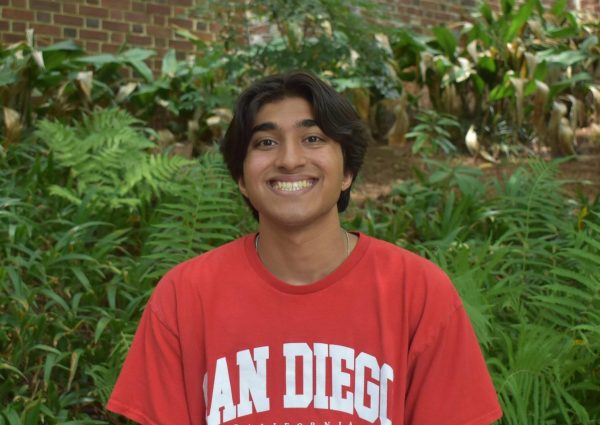Atlanta Iranian community backs Iranians in freedom fight
Protestors opposed to Iran’s regime stand in downtown Atlanta on Oct. 1. This was one of the several protests which occurred in cities around the world at the same time.
October 30, 2022
Following unprecedented protests in Iran in opposition to the country’s Islamic Republic’s strict actions, the Atlanta Iranian community has rallied to show support for Iranians.
The death of Mahsa Amini, a 22-year-old Iranian woman, at the hands of the nation’s morality police in September set off the protests. The morality police detained Amini outside a metro station in the capital of Tehran and took her into custody on the basis that she was breaking Iran’s mandatory hijab law.
The police transported Amini to a detention center, and witnesses claim she was beaten on the way. Following the assault, Amini spent three days in a coma before dying in an Iranian hospital. While Iranian officials claim Amini suffered a heart attack at the detention center, her family said she was in perfect health when detained.
Iranians were enraged following Amini’s death. The first protests took place following Amini’s funeral in the western city of Saqqez, where women ripped off their hijabs in solidarity. Since then, protests have swelled throughout the country, especially in the Kurdish-populated cities and towns in the west of the country.
Junior Arshia Larestani wasn’t surprised when he found out about Amini’s death. Larestani was 7 years old when he moved from Tehran to Atlanta with his parents and sister due to the country’s strict enforcement of Islam.
“When I found out, I thought, ‘They got away with it again,’” Larestani said. “They just casually took another person, killed them, and wrote it off as, ‘She just died of a heart attack.’ I thought that this wasn’t going to change anything and that [deaths] were still going to continue, but seeing how much that changed and how it shaped the protests and revolutions that are going on today is just amazing to me.”
Larestani said this specific death caused such uproar compared to other actions by the regime because it was the last the Iranian civilians could take from the Islamic Republic.
“[The death of Amini] was the last straw,” Larestani said. “People were already on the edge, and this just pushed them over it. The way she died – you’re not supposed to get away with that, and people lost it.”
Larestani believes freedom for women is restricted due to the morality police’s strict enforcement of the mandatory hijab law. Freshman Mahmoud Qazvini* is Iranian-American and notes that these officers are often pressured to enforce the law and that its enforcement is not always consistent.
“The enforcement, from what I know, is very sporadic,” Qazvini* said. “One day, [the morality police] might let you off, but the next day, they won’t; a lot of them are just conscripts.” According to an article from the Washington Post, “Beginning at age 18, Iranian men are required to complete 18 to 24 months of military service.”
Larestani said he believes the enforcement of the hijab law in Iran has become stricter over time starting with the Iranian Revolution between 1978 and 1979, which signified the beginning of the Islamic Republic’s rule in Iran. Iranian demands for freedom stretch back 40 years to the start of the Islamic Republic.
“Originally, [the regime] forced a hijab, but it wasn’t that widely enforced because a lot of people were protesting that they didn’t want to wear it,” Larestani said. “However, women then started wearing it, and [the enforcement] got really serious as the regime solidified its stance.”
Senior Momina Khpulwak was born in Afghanistan and moved to the U.S. when she was 8 years old. She said that, like Iran, Afghanistan also has strict policies on what women can wear.
“[Afghanistan’s] hijab law is to cover up with no skin showing from head to toe while covering the face with a fabric called ‘Niqab,’” Khpulwak said. “[Afghanistan] is strict on modest wear and covering up with the hijab just like Iran. Afghanistan is also close to Iran with its similarities in language.”
Khpulwak is a member of the Muslim Student Association, led by social studies teacher Millicent Green. Green said the association did not extensively discuss the death of Amini, but she could observe the members’ emotions surrounding the event, nonetheless.
“It’s my belief that [the members] all felt passionate about [the Amini incident] because everyone in the association does wear a hijab, so they do have a perspective on why they [wear] it,” Green said. “So, I think they still feel strongly about someone losing their life for choosing [to not wear a hijab].”
Today, unlike prior protests in the regime, the unrest is led by young women and schoolgirls who have risked their lives to fight for a country with more liberty and choice. Khpulwak finds this virtuous and believes the hijab should not be a catalyst for violence, but argues for caution in the boldness of these young women.
“It’s a good thing [young women] are protesting to get basic human rights that every single human deserves,” Khpulak said. “I feel that it is not right that the rights of women who choose not to wear the hijab should be taken away from them. [However], I believe that these women didn’t approach the situation correctly; it seems like they acted a little recklessly.”
Larestani’s father, Payam Larestani, stands with the fight of the young women. He said these women have repeatedly been looked down upon based on the nation’s culture under the Islamic Republic.
“I feel proud seeing young women of my country taking control of their bodies and their lives,” Payam Larestani said. “Women have always been second-class citizens under the regime.”
Khpulwak, who is Muslim, is concerned the events in Iran and the continuous inferiority of Iranian women have magnified misinformation about Islam.
“I’m also afraid that others might think that it is Islam that takes this right from them,” Khpulwak said. “However, [while] Islam does command us to wear the hijab and cover ourselves, Islam gives us a choice, and if you choose not to wear the hijab, no one is allowed to force it on you. [Morality police] aren’t allowed to beat you and take your life away from you.”
In an attempt to both protest the death of Amini and stand in solidarity with the young women of Iran, protestors gathered in cities around the world on Oct. 1. Larestani and his father Payam Larestani attended the protest in Atlanta, where protestors marched in the downtown area and chanted for democracy and freedom to emerge amid the chaos.
“It feels good when you see that people actually care about supporting others in hardship,” Payam Larestani said. “You also get a strong sense of nationalism through this.”
Qazvini is afraid of what the regime might do in response to protests, but is hopeful that the traction which protestors are gaining will lead to the end of the Islamic Republic.
“I’m terrified of what they (the regime) can do since I have family who are in minority religious groups,” Qazvini said. “It’s pretty scary what they can do and what they have done before; I wouldn’t put anything past them. All the protests go away after a month, but this time, people are starting to talk about the end of the Islamic Republic. If, somehow in this chaos, democracy can emerge, that would be great.”
Following the protests and the possibility of the end of the Islamic Republic, Green hopes Iran and the U.S. can put their differences aside and become allies. Payam Larestani agrees, hoping the regime can end once and for all.
“They are already killing and torturing protesters and political prisoners,” Payam Larestani said. “They have been doing this repeatedly for the past 43 years to our people. The people of Iran strongly believe that this is the last time they do this and that the revolution ends with them in ruins. I hope the regime falls and nothing like them ever rises to power again.” According to an article from Barron’s, “detainees who are often forcibly disappeared are at serious risk of torture and death.”
Mahmoud Qazvini* is a pseudonym for a source who wishes to be anonymous.







